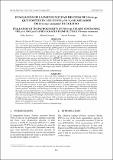Por favor, use este identificador para citar o enlazar este ítem:
https://hdl.handle.net/20.500.12958/3497Registro completo de metadatos
| Campo DC | Valor | Lengua/Idioma |
|---|---|---|
| dc.contributor.author | Ramírez, Beder | - |
| dc.contributor.author | Guevara Torres, Mervin | - |
| dc.contributor.author | Montoya, Vanessa | - |
| dc.contributor.author | Serna, María | - |
| dc.date.accessioned | 2021-01-08T04:06:32Z | - |
| dc.date.available | 2021-01-08T04:06:32Z | - |
| dc.date.issued | 2020 | - |
| dc.identifier.citation | Bol Inst Mar Perú. 35(2) 2020, p. 242-256 | es_ES |
| dc.identifier.issn | 04587766 | - |
| dc.identifier.uri | https://hdl.handle.net/20.500.12958/3497 | - |
| dc.description.abstract | Los vibrios son considerados principales patógenos bacterianos de langostinos. Se han reportado diferentes cepas de Vibrio parahaemolyticus que poseen genes pirA y pirB como causantes de la enfermedad de la necrosis aguda del hepatopáncreas (AHPND). En este trabajo, utilizando muestras de langostinos cultivados en la región Tumbes, se aislaron cinco cepas V. parahaemolyticus que son positivas por PCR para los genes pirA y pirB. Mediante ensayos de infección experimental con cuatro de estas cepas en langostinos de 1,8 ±0,3 g, se logró detectar que dos cepas producen mortalidad y daños histológicos en el hepatopáncreas que son característicos a la AHPND. Sin embargo, también se observó que a pesar que las dos cepas restantes son positivas por PCR para los genes pirA y pirB, no son patogénicas en los langostinos. Estos resultados muestran que las cepas V. parahaemolyticus presentes en el cultivo de langostinos de la región Tumbes tienen diferentes patrones de patogenicidad a pesar de ser positivos por PCR para los genes pirA y pirB, lo que sugiere que existen bacterias con factores adicionales a los genes pirA y pirB para causar la AHPND. | es_ES |
| dc.description.abstract | ABSTRACT: Vibrio species are considered the major bacterial pathogens affecting shrimps. It has been reported that acute hepatopancreatic necrosis disease (AHPND) is caused by different strains of Vibrio parahaemolyticus with pirA and pirB genes. In this paper, we isolated five V. parahaemolyticus strains that were positive by PCR for the genes pirA and pirB, from shrimps cultured in the Tumbes region. We detected that two strains produce mortality and histological damage in the hepatopancreas, characteristic of AHPND, through experimental infection assays with four of these strains in 1.8 ±0.3 g shrimps. Nevertheless, we also observed that although the two remaining strains are positive by PCR for the genes pirA and pirB, they are not pathogenic in shrimps. These results indicate that V. parahaemolyticus strains present in the shrimp culture from the Tumbes region have different patterns of pathogenicity despite being positive by PCR for the genes pirA and pirB. This suggests that there are bacteria with additional factors to the genes pirA and pirB to cause AHPN. | - |
| dc.language.iso | spa | es_ES |
| dc.language.iso | eng | - |
| dc.publisher | Instituto del Mar del Perú | es_ES |
| dc.relation.ispartofseries | Boletín Imarpe;35(2), 2020 | - |
| dc.rights | info:eu-repo/semantics/openAccess | es_ES |
| dc.rights.uri | https://creativecommons.org/licenses/by/4.0/ | es_ES |
| dc.source | Instituto del Mar del Perú - IMARPE | es_ES |
| dc.source.uri | Repositorio Digital IMARPE | es_ES |
| dc.subject | Penaeus vannamei | es_ES |
| dc.subject | Cepas de Vibrio sp | es_ES |
| dc.subject | Langostinos | es_ES |
| dc.subject | Histopatología | es_ES |
| dc.title | Evaluación de la patogenicidad de cepas de Vibrio sp. que contienen los genes pirA y pirB aislados de Penaeus vannamei de cultivo | es_ES |
| dc.title.alternative | Evaluation of the pathogenicity of Vibrio sp. strains containing pirA and pirB genes isolated from cultured Penaeus vannamei | es_ES |
| dc.type | info:eu-repo/semantics/article | es_ES |
| Aparece en las colecciones: | Boletín 35(2), 2020 | |
Ficheros en este ítem:
| Fichero | Descripción | Tamaño | Formato | |
|---|---|---|---|---|
| Bol 35(2)-4.pdf | 4,47 MB | Adobe PDF |  Visualizar/Abrir |
Este ítem está sujeto a una licencia Creative Commons Licencia Creative Commons

